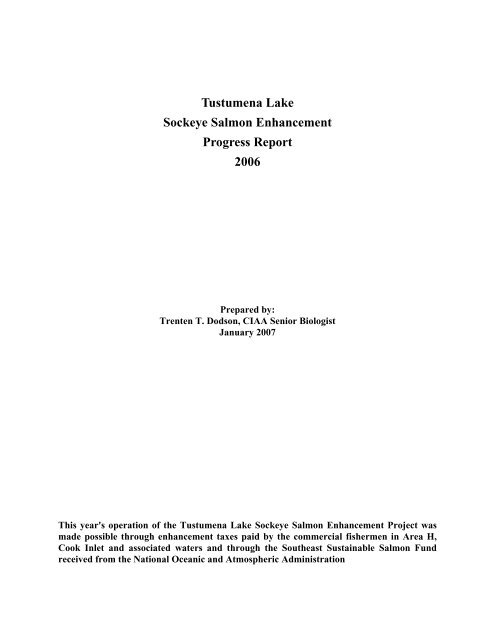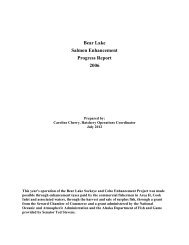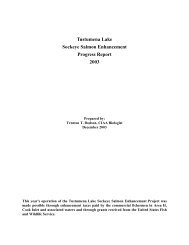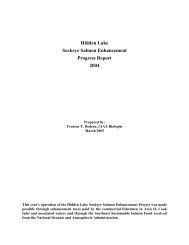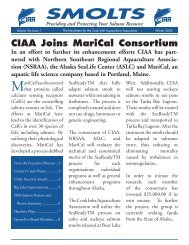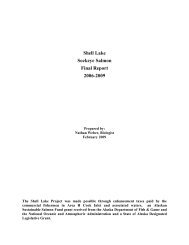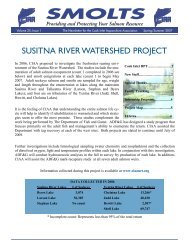Tustemena Lake 2006 - Cook Inlet Aquaculture Association, Kenai ...
Tustemena Lake 2006 - Cook Inlet Aquaculture Association, Kenai ...
Tustemena Lake 2006 - Cook Inlet Aquaculture Association, Kenai ...
You also want an ePaper? Increase the reach of your titles
YUMPU automatically turns print PDFs into web optimized ePapers that Google loves.
Tustumena <strong>Lake</strong><br />
Sockeye Salmon Enhancement<br />
Progress Report<br />
<strong>2006</strong><br />
Prepared by:<br />
Trenten T. Dodson, CIAA Senior Biologist<br />
January 2007<br />
This year's operation of the Tustumena <strong>Lake</strong> Sockeye Salmon Enhancement Project was<br />
made possible through enhancement taxes paid by the commercial fishermen in Area H,<br />
<strong>Cook</strong> <strong>Inlet</strong> and associated waters and through the Southeast Sustainable Salmon Fund<br />
received from the National Oceanic and Atmospheric Administration
This page intentionally left blank<br />
ii
DISCLAIMER<br />
The <strong>Cook</strong> <strong>Inlet</strong> <strong>Aquaculture</strong> <strong>Association</strong> conducts salmon enhancement and restoration projects<br />
in Area H, <strong>Cook</strong> <strong>Inlet</strong> and associated waters. As an integral part of these projects a variety of<br />
monitoring and evaluation studies are conducted.<br />
The purpose of these progress reports is to provide a vehicle to distribute the information<br />
produced by the monitoring and evaluation activities. Data collected each year are presented<br />
with a summary of the information previously collected for comparative purposes. These reports<br />
are intended to provide a general description of project activity and are not an exhaustive<br />
evaluation of any fisheries project. The information presented in each report has not undergone<br />
an extensive review. As reviews are completed, the information may be updated and presented<br />
in later progress reports.<br />
The following progress report is a synopsis of the monitoring and evaluation activities conducted<br />
for the Tustumena <strong>Lake</strong> sockeye salmon project.<br />
iii
This page intentionally left blank<br />
iv
ACKNOWLEDGEMENTS<br />
The <strong>2006</strong> Tustumena <strong>Lake</strong> smolt migration was conducted by the <strong>Cook</strong> <strong>Inlet</strong> <strong>Aquaculture</strong><br />
<strong>Association</strong> (CIAA). Smolt migration equipment was provided courtesy of the Alaska<br />
Department of Fish and Game, (ADF&G). CIAA interns Matt Backs and Kevin Lauscher spent<br />
many hours in the field assisting with the <strong>2006</strong> field activities. Their efforts are greatly<br />
appreciated. Ronald Carlson, CIAA Project Technician, and Lab Assistants, Cathy Cline and<br />
Bridget Dodson are also recognized for their assistance and hard work.<br />
v
This page intentionally left blank<br />
vi
TABLE OF CONTENTS<br />
DISCLAIMER............................................................................................................................................................. iii<br />
ACKNOWLEDGEMENTS...........................................................................................................................................v<br />
TABLE OF CONTENTS............................................................................................................................................ vii<br />
LIST OF FIGURES ......................................................................................................................................................ix<br />
LIST OF TABLES........................................................................................................................................................xi<br />
ABSTRACT ..................................................................................................................................................................1<br />
INTRODUCTION AND PURPOSE .............................................................................................................................3<br />
PROJECT AREA ..........................................................................................................................................................5<br />
METHODS....................................................................................................................................................................7<br />
Smolt Enumeration ....................................................................................................................................................7<br />
Adult Escapement....................................................................................................................................................12<br />
Gamete Collection, Incubation and Rearing ............................................................................................................12<br />
Fish Transport and Stocking ....................................................................................................................................12<br />
Adult Otolith Collection ..........................................................................................................................................12<br />
RESULTS AND DISCUSSION..................................................................................................................................13<br />
Environmental Conditions .......................................................................................................................................13<br />
Smolt Enumeration ..................................................................................................................................................13<br />
Adult Escapement....................................................................................................................................................14<br />
Fish Transport and Stocking ....................................................................................................................................14<br />
Adult Otolith Collection ..........................................................................................................................................14<br />
Gamete Collection ...................................................................................................................................................14<br />
RECOMMENDATIONS.............................................................................................................................................15<br />
LITERATURE CITED................................................................................................................................................17<br />
APPENDICES .............................................................................................................................................................19<br />
vii
This page intentionally left blank<br />
viii
LIST OF FIGURES<br />
Figure 1. Area Map of Bear Creek, a tributary to Tustumena <strong>Lake</strong>, near Soldotna, Alaska.........................................6<br />
ix
This page intentionally left blank<br />
x
LIST OF TABLES<br />
Table 1. Tustumena <strong>Lake</strong> smolt migrations – 1998 to 2005. ......................................................................................13<br />
Table 2. Tustumena <strong>Lake</strong> smolt characteristics – 1997 to 2005. ................................................................................14<br />
xi
This page intentionally left blank<br />
xii
ABSTRACT<br />
The Alaska Department of Fish and Game (ADF&G) began the Tustumena <strong>Lake</strong> sockeye<br />
enhancement program in 1974. In 1976, the first fry resulting from egg collections were released<br />
to Tustumena <strong>Lake</strong>. During the project, eggs were collected from Bear Creek, Glacier Flats<br />
Creek, and Seepage Creek in varying combinations. As the project progressed, as many as 23.6<br />
million eggs were collected and as many as 17.1 million fry were released into Tustumena <strong>Lake</strong>;<br />
and up to eight other lakes were stocked with fry of Tustumena origin. Currently 12 million<br />
eggs are collected from Bear Creek and 6 million are released to Tustumena <strong>Lake</strong> and 3.4<br />
million to three lower <strong>Cook</strong> <strong>Inlet</strong> lakes.<br />
In 1993, CIAA assumed operation of the Tustumena <strong>Lake</strong> sockeye enhancement program from<br />
ADF&G. Initially, ADF&G maintained the responsibility of conducting the Tustumena <strong>Lake</strong><br />
limnological sampling, smolt migration and adult escapement and CIAA accepted the<br />
responsibility of enumerating the spawning population at the Bear Creek gamete collection site,<br />
collecting gametes for the enhancement program, incubating, rearing and releasing the resulting<br />
fish. In 1998, CIAA assumed the responsibility of enumerating the smolt migration and<br />
conducting the limnological sampling.<br />
In January 2004, a ruling by the 9 th Circuit Court of Appeals found that the enhancement project<br />
occurring on Tustumena <strong>Lake</strong> was a commercial enterprise and thus, violated the Wilderness<br />
Act. As a result, the United States Fish and Wildlife Service were no longer able to provide<br />
CIAA with a permit to continue operations on Tustumena <strong>Lake</strong>. The resultant fry from the 2003<br />
egg collection were allowed to be released; however, all other activities were terminated.<br />
This report summarizes the <strong>2006</strong> Tustumena <strong>Lake</strong> smolt migration. The Bear Creek adult<br />
enumeration and gamete collection activities, otolith collection activities, and the limnological<br />
sampling were terminated in 2004.<br />
The enumeration of sockeye salmon smolts migrating from Tustumena <strong>Lake</strong> was conducted at<br />
mile 6.3 of the Kasilof River from 22 May to 26 June using a mark/recapture technique<br />
developed by ADF&G. The smolt migration totaled 2.8 million (± 756,000) fish and was<br />
composed of 90.7% (± 26.3%) age 1 smolts and 9.3% (± 3.6%) age 2 smolts. The age 1 smolts<br />
averaged 81.8 mm (± 0.86 mm) in length and 4.52 g (± 0.08 g) in weight; the age 2 smolts<br />
averaged 97.9 mm (± 2.26 mm) in length and 7.40 g (± 0.58 g) in weight. There were no fry<br />
released in 2005, thus smolts resulting from fry released by CIAA in 2004 made up 0.04%<br />
(±0.05%) of the migration.<br />
CIAA also sampled the hatchery outfall for hatchery-reared Tustumena stock adults returning to<br />
the hatchery. There were no adult sockeye observed at the Trail <strong>Lake</strong>s Hatchery outfall in <strong>2006</strong>.<br />
1
This page intentionally left blank<br />
2
INTRODUCTION AND PURPOSE<br />
In July 1993, the Alaska Department of Fish and Game (ADF&G) transferred operation of its<br />
Crooked Creek Salmon Hatchery to the <strong>Cook</strong> <strong>Inlet</strong> <strong>Aquaculture</strong> <strong>Association</strong> (CIAA). Prior to<br />
the transfer of hatchery operations to CIAA, Crooked Creek Hatchery incubated and reared<br />
sockeye (Onchorynchus nerka), coho (O. kisutch) and Chinook (O. tshawytscha) salmon and<br />
steelhead trout (O. mykiss) for release into various water bodies throughout the central and lower<br />
<strong>Cook</strong> <strong>Inlet</strong> drainage. While under CIAA management, the hatchery’s stocking programs focused<br />
on sockeye salmon releases to Tustumena <strong>Lake</strong>, several lower <strong>Cook</strong> <strong>Inlet</strong> <strong>Lake</strong>s and<br />
Resurrection Bay.<br />
In 1993, when CIAA began operating Crooked Creek Hatchery, ADF&G maintained the<br />
responsibility of monitoring the Tustumena <strong>Lake</strong> sockeye salmon smolt migration and adult<br />
escapement. CIAA accepted the responsibility of collecting the gametes (eggs and milt),<br />
incubating the eggs, rearing the fry and releasing the resulting fish to the designated water<br />
bodies.<br />
In November 1996, CIAA terminated operations at Crooked Creek Hatchery, suspended stocking<br />
activities at five lower <strong>Cook</strong> <strong>Inlet</strong> <strong>Lake</strong>s, and transferred the remaining stocking programs to its<br />
Trail <strong>Lake</strong>s and Eklutna hatcheries.<br />
In 1997, the Bear Creek gamete collection procedure and the Tustumena <strong>Lake</strong> fry stocking<br />
program were reviewed by the U.S. Fish and Wildlife Service. The U.S. Fish and Wildlife<br />
Service recommended several changes to these activities, which have been incorporated into the<br />
program.<br />
In 1998, operations at Eklutna Hatchery were suspended, and the hatchery’s Tustumena <strong>Lake</strong><br />
egg incubation and fry rearing activities were transferred to Trail <strong>Lake</strong>s Hatchery. During 1998,<br />
CIAA also assumed the responsibility of conducting the limnological sampling; and, thus<br />
became responsible for conducting all project activities, except the adult escapement monitoring,<br />
which is conducted by ADF&G. Under the this program, approximately twelve million eggs are<br />
3
collected to provide six million fry for rearing in Tustumena <strong>Lake</strong> and approximately 3.5 million<br />
for rearing in three Lower <strong>Cook</strong> <strong>Inlet</strong> lakes.<br />
The Wilderness Society and the Alaska Center for the Environment (ACE) brought suit against<br />
the U.S. Fish and Wildlife service challenging the issuance of a permit for the Tustumena<br />
enhancement project. After years of litigation, the 9 th Circuit Court of Appeals ruled, in January<br />
2004, that the enhancement project occurring on Tustumena <strong>Lake</strong> was a commercial enterprise<br />
and thus, violated the Wilderness Act. As a result, the United States Fish and Wildlife Service<br />
were no longer able to provide CIAA with a permit to continue operations on Tustumena <strong>Lake</strong>.<br />
The resultant fry from the 2003 egg collection were allowed to be released; however, all other<br />
activities were suspended.<br />
This report summarizes the <strong>2006</strong> the Kasilof River smolt enumeration. The Tustumena <strong>Lake</strong><br />
adult sockeye migration was completed by ADF&G and is reported by ADF&G.<br />
4
PROJECT AREA<br />
Tustumena <strong>Lake</strong> is located on the <strong>Kenai</strong> Peninsula in South-central Alaska (Figure 1). It is the<br />
largest lake on the <strong>Kenai</strong> Peninsula and the fifth largest lake in the State of Alaska. It is a glacial<br />
lake with a surface area of 294.5 km 2 . The mean depth is 24 m, and the maximum depth is 320<br />
m. The lake is fed by several clear-water streams and two glacial streams, which originate in the<br />
Harding Icefield (Kyle, 1992).<br />
Tustumena <strong>Lake</strong> is oligotrophic with mean open-water season total phosphorus, total Kjeldahl<br />
nitrogen and chlorophyll a concentrations of 3.7 μ/L, 155 μ/L, and 0.45 μ/L, respectively. The<br />
lake is turbid with glacial silt and light penetration is limited to the upper two meters (Kyle,<br />
1992).<br />
The zooplankton community consists of two copepods, Diaptomus pribilofensis and Cyclops<br />
columbianus. All five species of Pacific salmon, O. nerka, O. keta, O. gorbuscha, O.<br />
tshawytscha, and O. kisutch, are found in the Tustumena <strong>Lake</strong> system; however, it is mainly<br />
sockeye that utilize the limnetic area of the lake. Resident fish species include rainbow trout (O.<br />
mykiss), lake trout (Salvelinus namaycush), Dolly Varden char (S. malma), threespine<br />
stickleback (Gasterosteus aculeatus), coastrange and slimy sculpin (Cottus aleuticus and C.<br />
cognatus) and round whitefish (Prosopium cylindraceum) (Kyle, 1992)<br />
The Kasilof River, which flows 17.4 miles to <strong>Cook</strong> <strong>Inlet</strong>, forms the outlet. The smolt migration<br />
and the enumeration of the adult escapement occur in the Kasilof River.<br />
Bear Creek, a tributary of Tustumena <strong>Lake</strong> (Figure 1), is the site of the fry release and gamete<br />
collection. It is a moderately sized stream approximately 16 miles long with an average gradient<br />
of 185 feet/mile. The stream lies northeast of the lake and begins in the <strong>Kenai</strong> Mountains above<br />
tree line at an elevation of approximately 3,100 feet. The upper section of the creek flows with<br />
an average gradient of 260 feet/mile for 4.25 miles. At the tree line it enters a narrow canyon.<br />
The canyon dominates the middle section of the stream as it flows for the next 8.25 miles with an<br />
5
average gradient of 180 feet/mile. As the stream leaves the canyon, the gradient over the lower<br />
3.75 miles decreases to approximately 105 feet/mile. The former fry release and gamete<br />
collection site is located in the lower section of Bear Creek approximately 150 meters upstream<br />
of its confluence with Tustumena <strong>Lake</strong>.<br />
Figure 1. Area Map Tustumena <strong>Lake</strong> and the Kasilof River, near Soldotna, Alaska.<br />
6
METHODS<br />
CIAA’s <strong>2006</strong> Tustumena <strong>Lake</strong> fishery enhancement activities involved the enumeration of the<br />
Kasilof River smolt migration. The procedures used to enumerate the smolt migration are<br />
described below. In general, all procedures follow ADF&G recommendations.<br />
Smolt Enumeration<br />
This was the ninth year CIAA was responsible for enumerating the smolt migration from<br />
Tustumena <strong>Lake</strong>. The smolt migration was estimated by enumerating a known proportion of the<br />
migration following procedures developed by ADF&G. The following is a general description<br />
of the procedures.<br />
One inclined-plane smolt trap (Todd 1994) was placed in the Kasilof River near river mile 6.3 to<br />
capture a portion of the migrating smolts. The trap was operated from 22 May through 26 June<br />
<strong>2006</strong>. It consisted of an inclined plane lead, a live box, and a floating support structure; and<br />
measured 1.5 m in width, 1 m in height, and 3.8 m in length.<br />
Each day, the number of smolts captured by the trap was determined by individually counting<br />
and releasing each fish; or, when the daily smolt numbers exceeded 15,000 fish, the number of<br />
smolts captured was estimated using a biomass technique. To estimate the number of smolts<br />
captured by the biomass technique, the average weight of a sample of at least 50 smolts caught<br />
that day was divided into the total weight of all smolts captured (Todd and Kyle, 1996). Debris<br />
accumulating in the trap was also removed when the trap was checked for fish.<br />
The total number of sockeye smolts migrating from Tustumena <strong>Lake</strong> was estimated using<br />
weekly trap capture efficiencies determined by the recapture of marked fish. For the mark-andrecapture<br />
procedure, each week approximately 1,000 sockeye smolts were dyed 1 and released<br />
1 Fish were marked by placing them in a Bismark Brown Y dye bath (1.0g dye dissolved in 30 liters water) for 30<br />
minutes before being reintroduced into the river.<br />
7
upstream near river mile 7.1. The number of smolts recaptured was then used to estimate the<br />
proportion of migrating smolts captured (the trap capture efficiency) and the total smolt<br />
migration.<br />
Statistical procedures for estimating the population of migrating smolts (N) followed the simple<br />
stratified M-R design for One-Site sampling experiments described by Carlson et al. (1998)<br />
where:<br />
U = total unmarked population size;<br />
N = total population size;<br />
N h = total population size in stratum h;<br />
u h = total number of unmarked smolts captured in stratum h;<br />
M h = number of marked smolts released in stratum h;<br />
m h = number of marked smolts recaptured in stratum h;<br />
L = number of strata or periods; and<br />
Uˆ<br />
=<br />
∑<br />
ˆ<br />
∑<br />
( M + 1)<br />
L<br />
L h h<br />
N − =<br />
h= h<br />
M<br />
1 h h= 1<br />
mh<br />
+ 1<br />
The variance of the population estimate v(N) and the 95% confidence interval (CI) were<br />
estimated as:<br />
∑<br />
vN ( $ ) = vN ( $ ) =<br />
∑<br />
u<br />
( M + 1)( n + 1)( M − m )( n − m )<br />
; and<br />
( m + 1) ( m + 2)<br />
L L h h h h h h<br />
h= 1 h h=<br />
1<br />
2<br />
h<br />
h<br />
This method assumes:<br />
( CI) = N$ ±196 . v( N $ ) .<br />
• All marked fish released upstream pass the trap before the next release of marked<br />
fish;<br />
• The probability that a dyed or unmarked fish enters the trap equals the trap efficiency<br />
for all dyed or marked fish;<br />
• Fish are captured or not captured in the trap independently of the fate of other fish;<br />
• All fish entering the trap are counted, and;<br />
• Trap efficiencies do not change significantly during the smolt migration.<br />
The daily migration of sockeye smolts is presented in Appendix 2.<br />
8
The proportions of age 1, age 2, and age 3 smolts were calculated using the data computed from<br />
the aforementioned notations and formulas with the following notations and formulas:<br />
U i = total unmarked population size for age class = i;<br />
U h = total unmarked population size for stratum = h;<br />
U hi = total unmarked population size for age class i, in stratum = h;<br />
P i = proportion of unmarked smolt for age class = i;<br />
P h = proportion of unmarked smolt for stratum = h;<br />
P hi = proportion of unmarked smolt for age class = i, in stratum = h;<br />
a i = total number of samples of age class = i;<br />
The estimated number of migrating age = i smolts was calculated as:<br />
U = ∑U<br />
Proportion of age = i smolts was calculated as:<br />
Pi<br />
= 1<br />
∑U<br />
hPhi<br />
U<br />
The variance of the proportion of age = i smolts in stratum = h was calculated as:<br />
v<br />
i<br />
( P )<br />
hi<br />
=<br />
Phi<br />
a<br />
h<br />
P<br />
hi<br />
( 1−<br />
P )<br />
h<br />
−1<br />
The variance of the number of age = i smolts in stratum = h was calculated as:<br />
hi<br />
v<br />
2<br />
2<br />
( U ) = U v( P ) + P ( U ) − v( U )( P )<br />
hi<br />
h<br />
hi<br />
hi<br />
h<br />
h<br />
hi<br />
Therefore, the variance of the estimated number of age = i smolts was calculated as:<br />
v<br />
( U ) v( U )<br />
i<br />
∑<br />
=<br />
hi<br />
Confidence intervals (95%) estimates for number of age = i smolts are:<br />
U ± 1. 96<br />
v<br />
( )<br />
i<br />
U i<br />
Since 1976, ADF&G or CIAA has released sockeye salmon fry directly to Tustumena <strong>Lake</strong> or to<br />
Bear Creek, a tributary of Tustumena <strong>Lake</strong>, for rearing in Tustumena <strong>Lake</strong>. Since 1996, CIAA<br />
9
has marked the otoliths of all sockeye fry rearing in Tustumena <strong>Lake</strong> with a thermal band 2 . The<br />
purpose of the thermal band was to identify released fish in the population of smolt migrating<br />
from Tustumena <strong>Lake</strong> or adults migrating back to the lake.<br />
In <strong>2006</strong>, to assess the enhancement program, CIAA collected a sample of sockeye smolts<br />
migrating from the lake to determine age, weight, and length characteristics of the migrating<br />
population and to estimate the proportion of enhanced fish in the smolt migration. Smolts<br />
collected for evaluation, were collected daily in proportion to the number of smolts captured by<br />
the inclined-plane trap. This was accomplished by collecting a sample of migrating smolts<br />
approximately equal to 0.2% of the fish captured. Each sockeye smolt collected for evaluation<br />
was first measured to the nearest millimeter for fork length 3 and then weighed to the nearest 0.1<br />
gram. Several scales were removed from the primary growth area 4 and mounted on a glass slide<br />
for subsequent age determination.<br />
The otoliths of the collected smolts were removed and placed in a labeled 1dram vial. Ethanol<br />
was added to the vial to cover the otoliths; and, after the smolt migration was complete, the<br />
otoliths were shipped to CIAA headquarters. Lab staff processed the otoliths and checked each<br />
for a hatchery thermal mark following procedures described by Glick and Shields (1993).<br />
In <strong>2006</strong>, 549 otoliths were processed and 542 were readable. The enhancement contribution of<br />
the migrating smolts was calculated using the same notations and formulas as reported above,<br />
but with following exception: i = hatchery or wild.<br />
2 The otolith mark is a series of hatchery induced bands produced by controlled temperature changes during<br />
incubation.<br />
3 Standard fork length was measured from the tip of the snout to the fork of the tail.<br />
4 Located above the lateral line on a diagonal from the posterior insertion of the dorsal fin to the anterior insertion of<br />
the anal fin.<br />
10
Sockeye smolt characteristics (average weight and length) for captured smolts were estimated<br />
with the following notations and formulas.<br />
If:<br />
y = weight or length of fish<br />
c<br />
i<br />
= number of age = i smolts sample<br />
Mean weight or length was calculated as:<br />
∑ y<br />
yi<br />
=<br />
c<br />
The standard deviation for weight and length of each age class was calculated as:<br />
σ<br />
y<br />
i<br />
i<br />
i<br />
( y )<br />
ci∑<br />
yi<br />
− ∑<br />
=<br />
c<br />
i<br />
( c −1)<br />
Confidence intervals (95%) for the mean weight and length are, therefore:<br />
i<br />
i<br />
2<br />
y<br />
i<br />
⎛ σ<br />
y<br />
= ± ⎜ i<br />
1 .96<br />
⎝ ci<br />
⎞<br />
⎟<br />
⎠<br />
11
Adult Escapement<br />
Monitoring of the <strong>2006</strong> Tustumena <strong>Lake</strong> adult sockeye escapement was completed by ADF&G.<br />
Based on preliminary information developed by ADF&G, the total estimated <strong>2006</strong> Tustumena<br />
<strong>Lake</strong> sockeye return was 1,658,000 fish; with a commercial harvest of 1,211,408, personal use<br />
harvest of 75,000, a sport fish harvest of 5,500, and a lake escapement of 366,592. The <strong>2006</strong><br />
adult return data will be finalized and reported by ADF&G.<br />
Gamete Collection, Incubation and Rearing<br />
CIAA no longer collects gametes at Tustumena <strong>Lake</strong><br />
Fish Transport and Stocking<br />
CIAA no longer releases fish at Tustumena <strong>Lake</strong>.<br />
Adult Otolith Collection<br />
During the <strong>2006</strong> season, CIAA did not collect otoliths.<br />
12
RESULTS AND DISCUSSION<br />
Environmental Conditions<br />
Environmental conditions during the Kasilof River smolt migration were monitored from 22<br />
May to 26 June <strong>2006</strong>. Stream Stage measurements averaged 0.97 feet and ranged from 0.26 to<br />
2.15 feet. During the period of the smolt migration, river temperatures averaged 10.3°C and<br />
ranged from 8 to 12°C. Air temperatures averaged 12.1°C and ranged from 8 to 21°C. Thirtythree<br />
percent of the days were clear, 31% were partly cloudy, and 36% were completely<br />
overcast. A total of 4 mm of rain fell during this period (Appendix 1).<br />
Smolt Enumeration<br />
Based on the statistical analysis a total of 2.8 million (± 756,000) sockeye smolts migrated from<br />
Tustumena <strong>Lake</strong> (Table 1) in 2005. There were no fry released in 2005, thus smolts resulting<br />
from fry released by CIAA in 2004 made up 0.04% (±0.05%) of the migration. In 2007, there<br />
will be no smolts resulting from CIAA releases.<br />
Table 1. Tustumena <strong>Lake</strong> smolt migrations – 1998 to <strong>2006</strong>.<br />
Smolt Total 95% % 95%<br />
Year (million) C.I. Wild Hatchery Hatchery C.I.<br />
1998 4.6 (+395,000) 3,872,000 727,000 15.8 (+2.2)<br />
1999 4.5 (+461,000) 3,555,000 945,000 21.0 (+2.5)<br />
2000 4.3 (+526,000) 3,986,000 316,000 7.4 (+1.8)<br />
2001 5.3 (+612,000) 5,155,000 105,000 1.9 (+1.0)<br />
2002 3.5 (+618,000) 3,474,000 0 0 0<br />
2003 12.9 (+2,437,000) 10,619,000 2,329,000 18.0 (+4.6)<br />
2004 6.4 (+997,000) 3,155,000 3,140,000 49.9 (+12.6)<br />
2005 11.2 (+2,152,000) 7,631,000 3,592,000 32.0 (+7.4)<br />
<strong>2006</strong> 2.8 (+756,000) 2,833,000 10,600 0.4 (+0.5)<br />
Average 6.2 4,920,000 1,240,511<br />
13
The smolt migration was composed of 90.7% (± 26.3%) age 1 smolts and 9.3% (± 3.6%) age 2<br />
smolts (Table 2). The age 1 smolts averaged 81.8 mm (± 0.86 mm) in length and 4.52 g (± 0.08<br />
g) in weight; the age 2 smolts averaged 97.9 mm (± 2.26 mm) in length and 7.40 g (± 0.58 g) in<br />
weight. Both age classes of smolts were the largest on record for the entire history of the smolt<br />
enumeration project (1980 – <strong>2006</strong>).<br />
Table 2. Tustumena <strong>Lake</strong> smolt characteristics – 1997 to <strong>2006</strong>.<br />
Age Class (%) Mean length (mm) Mean weight (g)<br />
Smolt Age 95% Age 95% Age 95% Age 95% Age 95% Age 95%<br />
Year 1.0 C.I. 2.0 C.I. 1.0 C.I. 2.0 C.I. 1.0 C.I. 2.0 C.I.<br />
1997 64.7 35.3 76.9 86.6 3.90 5.20<br />
1998 79.5 20.5 74.5 (+0.36) 84.9 (+1.03) 3.75 (+0.05) 5.43 (+0.16)<br />
1999 77.7 (+9.6%) 22.3 (+3.8%) 76.8 (+0.34) 88.6 (+0.66) 3.85 (+0.05) 5.77 (+0.13)<br />
2000 81.3 (+11.5%) 18.7 (+4.2%) 73.4 (+0.32) 86.0 (+0.73) 3.20 (+0.05) 5.01 (+0.12)<br />
2001 60.7 (+9.5%) 38.2 (+6.3%) 72.3 (+0.39) 83.7 (+0.53) 3.26 (+0.05) 5.07 (+0.08)<br />
2002 39.4 (+24.1%) 60.9 (+24.8%) 74.4 (+0.42) 81.9 (+0.64) 3.66 (+0.06) 5.16 (+0.11)<br />
2003 74.2 (+16.2%) 24.8 (+6.4%) 77.8 (+0.42) 90.5 (+0.15) 4.80 (+0.07) 7.20 (+0.15)<br />
2004 64.7 (+13.3%) 35.2 (+8.1%) 79.3 (+0.42) 91.7 (+0.57) 4.30 (+0.07) 6.60 (+0.12)<br />
2005 91.0 (+19.0%) 9.0 (+2.3%) 76.4 (+0.25) 90.9 (+0.74) 3.90 (+0.72) 6.40 (+1.19)<br />
<strong>2006</strong> 90.7 (+26.3%) 9.3 (+3.6%) 81.8 (+0.86) 97.9 (+2.26) 4.52 (+0.08) 7.40 (+0.58)<br />
Ave 72.4 27.4 76.4 88.3 3.91 5.92<br />
Note: 2001 smolt migration inclueded 1.1% (+0.07%) age class 3 smolt<br />
Note: 2003 smolt migration inclueded 1% (+0.8%) age class 3 smolt<br />
Adult Escapement<br />
Escapement at Bear Creek was not conducted in 2005<br />
Fish Transport and Stocking<br />
CIAA no longer releases fish at Tustumena <strong>Lake</strong>.<br />
Adult Otolith Collection<br />
CIAA did not collect adult otoliths in 2005.<br />
Gamete Collection<br />
CIAA did not collect gametes from Bear Creek sockeye salmon in 2004.<br />
14
RECOMMENDATIONS<br />
There are no recommendations.<br />
15
This page is intentionally left blank<br />
16
LITERATURE CITED<br />
Carlson, S.R., Coggins, L.G. and C. O. Swanton. 1998. A Simple Sratified Design for Mark-<br />
Recapture Estimation of Salmon Smolt Runs. Alaska Fishery Research Bulletin. 5(2):88-<br />
102.<br />
Glick, W.J. and P.A. Shields. 1993. Juvenile Salmonid Otolith Extraction and Preparation<br />
Techniques for Microscopic Examination. Alaska Department of Fish and Game,<br />
Division of Commercial Fisheries Management and Development. Report No. 132.<br />
Soldotna, AK.<br />
Todd, G.L. 1994. A Lightweight, Inclined-plane Trap for Sampling Smolts in Rivers. Alaska<br />
Fishery Research Bulletin. 1(2):179-186.<br />
Todd, G.L. and G. B. Kyle. 1996.Sockeye Salmon Investigations and Limnological Sampling on<br />
Tustumena <strong>Lake</strong>: 1995 Annual Report. Alaska Department of Fish and Game. Regional<br />
Information Report No. 5J96-06. Division of Commercial Fisheries Management and<br />
Development. Juneau, AK. 24 pp.<br />
17
This page is intentionally left blank<br />
18
APPENDICES<br />
19
This page is intentionally left blank<br />
20
Appendix 1. Kasilof River <strong>2006</strong> - Environmental Conditions<br />
Smolts Water Air<br />
Precip. Stage Temp. Temp.<br />
Date Sky (mm) (ft) Flow (oC) (oC)<br />
22-May ND ND ND ND ND ND<br />
23-May 1 0 0.26 ND 9.0 15.0<br />
24-May 2 0 0.30 ND 10.5 19.0<br />
25-May 1 0 0.34 ND 10.0 19.0<br />
26-May 2 0 0.35 ND 12.0 21.0<br />
27-May 3 0 0.38 ND 10.0 10.0<br />
28-May 1 0 0.40 ND 12.0 18.0<br />
29-May 2 0 0.44 ND 11.5 17.0<br />
30-May 4 0 0.48 ND 9.5 11.5<br />
31-May 5 0 0.50 ND 9.5 12.0<br />
1-Jun 3 0 0.54 ND 8.5 13.5<br />
2-Jun 1 0 0.57 ND 8.0 15.0<br />
3-Jun 1 0 0.60 ND 11.0 17.0<br />
4-Jun 1 0 0.60 ND 10.5 12.5<br />
5-Jun 1 0 0.62 ND 10.0 14.0<br />
6-Jun 1 0 0.65 ND 10.0 13.0<br />
7-Jun 3 0 0.67 ND 10.0 9.5<br />
8-Jun 4 0 0.70 ND 10.0 10.0<br />
9-Jun 4 0 0.76 ND 10.0 12.5<br />
10-Jun 3 0 0.79 ND 8.0 9.0<br />
11-Jun 4 0 0.86 ND 9.0 8.5<br />
12-Jun 5 0 0.92 ND 9.0 8.0<br />
13-Jun 4 0 0.96 ND 8.5 8.5<br />
14-Jun 4 0 1.10 ND 9.0 9.0<br />
15-Jun 3 0 1.08 ND 9.0 8.5<br />
16-Jun 5 0 1.17 ND 9.5 10.5<br />
17-Jun 3 4 1.23 ND 10.0 10.0<br />
18-Jun 4 0 1.27 ND 10.5 7.5<br />
19-Jun 4 0 1.34 ND 10.0 7.5<br />
20-Jun 3 0 1.40 ND 9.5 7.5<br />
21-Jun ND ND ND ND ND ND<br />
22-Jun 5 1 1.50 ND 9.4 9.0<br />
23-Jun 3 1 1.72 ND 10.0 13.0<br />
24-Jun 1 0 1.90 ND 11.0 11.0<br />
25-Jun 1 0 2.00 ND 12.0 13.0<br />
26-Jun 4 ND 2.06 ND 10.0 10.0<br />
27-Jun 1 0 2.15 ND 12.0 12.0<br />
28-Jun 1 0 2.15 ND 12.0 15.0<br />
Total 7<br />
ND = No Data<br />
1 = Clear<br />
2 = Cloud Cover 50%<br />
4 = Overcast<br />
5= Rain<br />
21
Appendix 2. Kasilof River <strong>2006</strong> - Smolt Migration<br />
Number of<br />
Date<br />
Migrants<br />
5/22/2004 2,143<br />
5/23/2004 1,786<br />
5/24/2004 2,524<br />
5/25/2004 12,357<br />
5/26/2004 16,929<br />
5/27/2004 16,238<br />
5/28/2004 15,857<br />
5/29/2004 19,357<br />
5/30/2004 31,524<br />
5/31/2004 87,500<br />
6/1/2004 37,381<br />
6/2/2004 32,738<br />
6/3/2004 17,405<br />
6/4/2004 69,643<br />
6/5/2004 22,381<br />
6/6/2004 13,810<br />
6/7/2004 123,214<br />
6/8/2004 63,190<br />
6/9/2004 66,857<br />
6/10/2004 24,048<br />
6/11/2004 15,833<br />
6/12/2004 12,929<br />
6/13/2004 11,190<br />
6/14/2004 50,905<br />
6/15/2004 50,024<br />
6/16/2004 169,643<br />
6/17/2004 687,690<br />
6/18/2004 560,333<br />
6/19/2004 476,952<br />
6/20/2004 80,357<br />
6/21/2004 24,857<br />
6/22/2004 7,048<br />
6/23/2004 22,690<br />
6/24/2004 43,619<br />
6/25/2004 17,286<br />
6/26/2004 1,429<br />
* 2,909,667<br />
* This number represents raw data<br />
that has not been statistically<br />
evaluated<br />
22
Appendix 3. Tustumena <strong>Lake</strong> <strong>2006</strong> - Project Update<br />
Smolt Migration<br />
Dates:<br />
18-May to 28-Jun<br />
Sockeye total migration: 2,844,000 (+756,000)<br />
Age 1: 90.7% (+26.3%) 2,579,000 (+749,000)<br />
Age 2: 9.3% (+3.6%) 266,000 (+103,000)<br />
Hatchery: 0.04% (+0.05%) 10,600 (+14,800)<br />
Adult Migration*<br />
Dates: ND to ND<br />
Sockeye return to <strong>Cook</strong> <strong>Inlet</strong>: 1,658,500<br />
Tustumena Escapement: 366,592 22.1%<br />
Commercial Harvest: 1,211,408 73.0%<br />
Personal Use Harvest: 75,000 4.5%<br />
Sport Harvest: 5,500 0.3%<br />
*Migration data provided by ADF&G<br />
7,000,000<br />
6,000,000<br />
5,000,000<br />
4,000,000<br />
3,000,000<br />
2,000,000<br />
1,000,000<br />
0<br />
<strong>2006</strong><br />
Kasilof Sockeye Smolt<br />
Migration<br />
Ave 98-05<br />
13-May<br />
16-May<br />
19-May<br />
22-May<br />
25-May<br />
28-May<br />
31-May<br />
3-Jun<br />
6-Jun<br />
9-Jun<br />
12-Jun<br />
15-Jun<br />
18-Jun<br />
21-Jun<br />
24-Jun<br />
27-Jun<br />
30-Jun<br />
3-Jul<br />
6-Jul<br />
23


